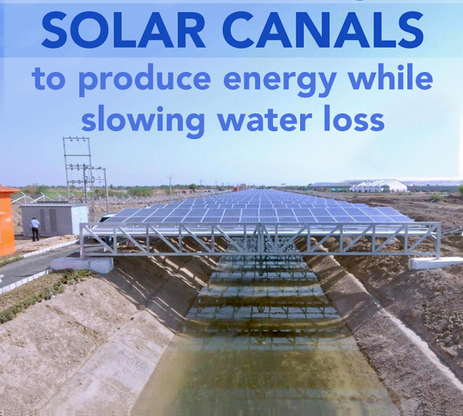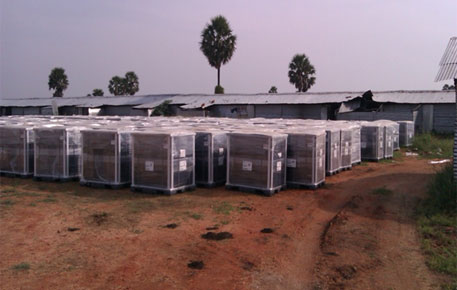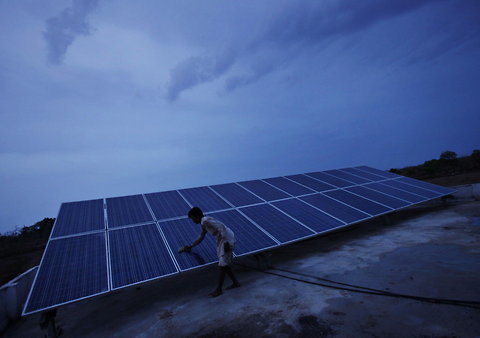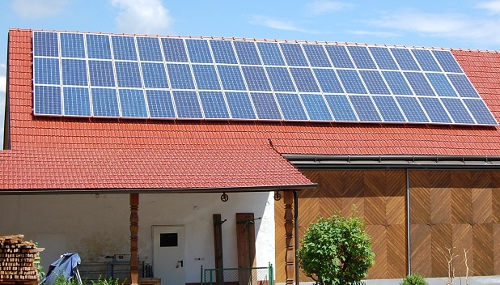by Johnson
After years of lagging behind China and the West in the adoption of solar power, some states in India are proposing to build solar farms at a galloping pace… a pace, if not adhered to, would render them at a risk of falling short of electricity (a familiar problem here) or of paying much higher prices for it.
In just the last five months, five Indian states have announced plans to bring giant amounts of solar power online within five years, including 1,000 megawatts in Andhra Pradesh, 350 megawatts in Rajasthan, 800 megawatts in Madhya Pradesh, 1,000 megawatts in Chhatisgarh and a whopping 3,000 megawatts in Tamil Nadu.
In just the last five months, five Indian states have announced plans to bring giant amounts of solar power online within five years, including 1,000 megawatts in Andhra Pradesh, 350 megawatts in Rajasthan, 800 megawatts in Madhya Pradesh, 1,000 megawatts in Chhatisgarh and a whopping 3,000 megawatts in Tamil Nadu.
Tamil Nadu has recently launched one of the most ambitious solar policies by any state in the country. It has mandated that all high tension consumers source six per cent of their energy usage from solar power by January 2014 through a Solar Purchase Obligation (SPO). High tension users include Large Industries, Special Economic Zones, Colleges, Residential Schools and Buildings with a built-up area of over 20,000 square metres. The six per cent SPO will help the state harness 3,000 MW of total solar power by 2015.
By comparison, the entire nation of India currently has just over 1,000 megawatts of solar power, and California, the leader in solar power in the United States, has around 2,000 MW. India has more than 300 sunny days a year and much of the nation lies near the equator — ideal conditions, geographically speaking, for harnessing solar power.
The central government has a goal of producing 22 gigawatts of solar power by 2022. Proponents say that solar energy might reduce the country’s dependence on coal, which is always in short supply, and slow the effects of climate change, including sea-level rise, which endangers the country’s coastal cities.
The national government, known here as the Center, intends to lean heavily on the states in working toward that target. And in the last few months a handful of states have emphatically responded. “The momentum is shifting from the Center to the states,” said Vineeth Vijayaraghavan, who publishes a newsletter on the Indian clean tech industry.
The national government, known here as the Center, intends to lean heavily on the states in working toward that target. And in the last few months a handful of states have emphatically responded. “The momentum is shifting from the Center to the states,” said Vineeth Vijayaraghavan, who publishes a newsletter on the Indian clean tech industry.
However much will depend upon how the Solar Panels are placed.
Will they be installed after taking over agricultural land or land where people reside?
Would the companies destroy the forest to create farms that would do nothing else than use sunlight to create energy? While a forest did much more than just create energy.
A single use installation like a solar farm would be detrimental both for human and for nature while a dual or multi use installation like a rooftop installation or a solar farm (built 8 feet over an existing farm), or placing solar cells on the external surface of a building is better as it has more than one use similar to a Tree.
Will they be installed after taking over agricultural land or land where people reside?
Would the companies destroy the forest to create farms that would do nothing else than use sunlight to create energy? While a forest did much more than just create energy.
A single use installation like a solar farm would be detrimental both for human and for nature while a dual or multi use installation like a rooftop installation or a solar farm (built 8 feet over an existing farm), or placing solar cells on the external surface of a building is better as it has more than one use similar to a Tree.
You uproot a tree you uproot an universe, as many living things depend on it - living things like people, birds & insects, A tree is in effect a natural multiple energy generating powerhouse, it has more than 5 uses (is it any surprise that the ancient Hindus had a lot of respect for the tree):
1. Creates oxygen and carbon di-oxide.
2. Creates shade,
3, Uses sunlight to create its own food.
4. Creates wood for multiple uses.
5. Creates fruits for consumption & flower for nectar.
6. Tree Bark for creating multiple things depending upon the tree.
Thus a successful Solar Plant must have multiple applications. But residential use (providing shelter) and creating energy is the basic of the applications. Then we can create concave mirror type of panels that would converge the sun light to a focal point to create heat. Thus it creates 1. Shade, 2. Electricity. 3 Heat. The best of minds have to come together to design other more interesting applications that can be made out of solar farms.Even with these 3 uses many applications can be created to solve a lot of problems faced by mankind.
1. Creates oxygen and carbon di-oxide.
2. Creates shade,
3, Uses sunlight to create its own food.
4. Creates wood for multiple uses.
5. Creates fruits for consumption & flower for nectar.
6. Tree Bark for creating multiple things depending upon the tree.
Thus a successful Solar Plant must have multiple applications. But residential use (providing shelter) and creating energy is the basic of the applications. Then we can create concave mirror type of panels that would converge the sun light to a focal point to create heat. Thus it creates 1. Shade, 2. Electricity. 3 Heat. The best of minds have to come together to design other more interesting applications that can be made out of solar farms.Even with these 3 uses many applications can be created to solve a lot of problems faced by mankind.
Tamil Nadu modeled its bidding process after one that worked out strongly in the central government’s favor. In 2011, the center sought bids for solar power and was overwhelmed by suitors — it received 5,000 megawatts’ worth of proposals for 1,000-megawatt projects. The government held a novel reverse auction that made solar developers compete with one another to see who could sell power to the state more cheaply. The resulting rates saved the utility and its customers significant money.
Tamil Nadu introduced its own 1,000-megawatt offer last October, and initial interest by solar developers was intense. But some companies grew wary when they examined the fine print. Rules were vague about when payments would be made; the state’s power distributor, known as Tangedco, is in poor financial health, which makes it harder for solar builders to secure loans; and the utility took no responsibility for transmitting the electricity that the developers created.

Gujarat is set to potentially use the existing 19,000 km-long network of Narmada canals across the State for setting up solar panels to generate power.
Known as Canal Solar Power Project, 1 megawatt (mw) pilot project, which is already commissioned, on Narmada branch canal near Chandrasan village of Kadi taluka in Mehsana district on Tuesday.
The pilot project will generate 16 lakh unitsof clean energy per annum and also prevent evaporation of 90Lakh (9 Million) litres of water annually from the canal….
When completed, the SSNNL’s canal network will be about 85,000 km long.Assuming a utilization of only 10 per cent of the existing canal network of 19,000 km, it is estimated that 2,200 MW of solar power generating capacity can be installed by covering the canals with solar panels.
This also implies that 11,000 acres of land can be potentially conserved along with about 2,000 crore litres of water saved per annum.
Known as Canal Solar Power Project, 1 megawatt (mw) pilot project, which is already commissioned, on Narmada branch canal near Chandrasan village of Kadi taluka in Mehsana district on Tuesday.
The pilot project will generate 16 lakh unitsof clean energy per annum and also prevent evaporation of 90Lakh (9 Million) litres of water annually from the canal….
When completed, the SSNNL’s canal network will be about 85,000 km long.Assuming a utilization of only 10 per cent of the existing canal network of 19,000 km, it is estimated that 2,200 MW of solar power generating capacity can be installed by covering the canals with solar panels.
This also implies that 11,000 acres of land can be potentially conserved along with about 2,000 crore litres of water saved per annum.
Conclusion:
If by 2022 India is capable of producing even 22 Giga-watts of clean and cheap electric power and added to the fact that by 2022 the prices of lithium-ion batteries will be cheaper than the lead-acid batteries more and more vehicle manufacturing companies would move towards manufacturing Electric Vehicles powered by clean solar power.
To put things into perspective 1 Megawatt can power about a thousand houses. Thus 22 Giga-watts can power 22 million houses so it could easily translate to a real world situation for a demand of more than 40 million Electric Vehicles in India alone!
The situation would be similar in other parts of the World. The total expected world wide demand could be close to 100 million electric vehicles.
I wonder which company would have the foresight to design the correct type of 2 wheeler, 4-wheeler, E-Truck and E-Buses to cater to this demand? But definitely... the future looks promising!
If by 2022 India is capable of producing even 22 Giga-watts of clean and cheap electric power and added to the fact that by 2022 the prices of lithium-ion batteries will be cheaper than the lead-acid batteries more and more vehicle manufacturing companies would move towards manufacturing Electric Vehicles powered by clean solar power.
To put things into perspective 1 Megawatt can power about a thousand houses. Thus 22 Giga-watts can power 22 million houses so it could easily translate to a real world situation for a demand of more than 40 million Electric Vehicles in India alone!
The situation would be similar in other parts of the World. The total expected world wide demand could be close to 100 million electric vehicles.
I wonder which company would have the foresight to design the correct type of 2 wheeler, 4-wheeler, E-Truck and E-Buses to cater to this demand? But definitely... the future looks promising!






